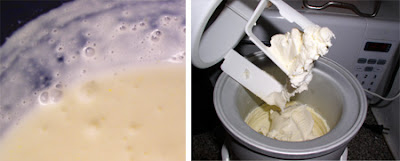While doing research for the upcoming event at the Merchant’s house, I came across an interesting account of how Irish immigrants in the mid-century cooked potatoes:
“We have all wondered why our Irish servants persist in bringing half-boiled potatoes to the table, notwithstanding our repeated orders to the contrary. Dr. James Johnson, in his tour in Ireland, discovered that it was almost a universal custom among the poor of the country, to only half boil their potatoes, leaving the center so hard, that it is called the bone of the potato.” (Breakfast, Dinner and Tea, Viewed Classically, Poetically, and Practically, 1859)
“…I have since read further descriptions of ‘potatoes with a bone’ as early as 1812. The preference developed in hard times, for the undercooked potato was harder to digest, and seemed to stop hunger for a longer time.” (The American History Cookbook, Mark H. Zanger, 2003)
Essentially, the Irish way of making a potato is grossly under cook them. In addition to Zanger’s theory that the raw potatoes staved off hunger, it seems even more logical that by boiling the potatoes for half the time, they were also using half the fuel for their fires. It seems the Irish developed a taste for the half-raw potatoes, and brought the tradition with them to America. Irish women were often hired as cooks for American households; potatoes with the bone in did not go over well with their mistresses. The appropriate way of preparing vegetables in the 19th century was to boil them to a mush–up to three hours for fresh veggies.
***
Potatoes with the Bone In
Modern Recipe from The American History Cookbook by Mark Zanger
1. Peel potatoes.
2. Put whole potatoes in a pot with water to cover by one inch and one tablespoon salt.
3. Bring to a boil; reduce heat and simmer with lid off or ajar.
4. After 15 minutes, begin testing by pushing a fork into the center of a potato. When it goes in halfway and meets a hard part, the “bone,” the potatoes are ready.
**
Zanger suggests this would have been eaten with a cup of milk; a meal I’m familiar with from my Tenement Diet days. A starch and some protein will fill you up.
Rating: D. It’s actually not as bad as I expected them to be; but it tastes pretty “green.” Like a raw potato.
Fear not, however. There will be plenty cooked food to eat tonight as well. I have four perfect cider cakes and a pot of spiced carrot soup for the event tonight, as well as some mid-19th century cocktails up my sleeve.
 Left: The fresh starter. Right: After 48 hours.
Left: The fresh starter. Right: After 48 hours.




 Ellis Island Dining Room (Tenement Museum Blog)
Ellis Island Dining Room (Tenement Museum Blog)

